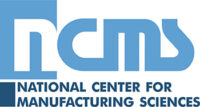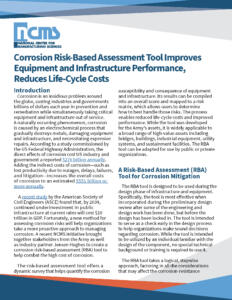NCMS Technology Briefs highlight NCMS’s cultivation and growth of innovative technologies. Through our management of government and industry collaborations, we’ve gained insights into novel approaches and best practices that can assist all companies to navigate the sometimes complex journey toward advancement. Based on the results of NCMS technology projects, the briefs show the applicability and usefulness of proven technical advances—all in an effort to speed adoption and eliminate duplication of effort. NCMS is pleased to share these insights to support U.S. manufacturing competitiveness.
Corrosion is an insidious problem around the globe, costing industries and governments billions of dollars each year in prevention and remediation while simultaneously taking critical equipment and infrastructure out of service. A naturally occurring phenomenon, corrosion is caused by an electrochemical process that gradually destroys metals, damaging equipment and infrastructure, and necessitating expensive repairs. According to a study commissioned by the US Federal Highway Administration, the direct effects of corrosion cost US industry and government a reported $276 billion annually. Adding the indirect costs of corrosion—such as lost productivity due to outages, delays, failures, and litigation—increases the overall costs of corrosion to an estimated $551 billion or more annually.
A recent study by the American Society of Civil Engineers (ASCE) found that, by 2039, continued underinvestment in public infrastructure at current rates will cost $10 trillion in GDP. Fortunately, a new method for assessing corrosion risks will help organizations take a more proactive approach to managing corrosion. A recent NCMS initiative brought together stakeholders from the Army as well as industry partner Jensen Hughes to create a corrosion risk-based assessment (RBA) tool to help combat the high cost of corrosion.
The risk-based assessment tool offers a dynamic survey that helps quantify the corrosion susceptibility and consequence of equipment and infrastructure. Its results can be compiled into an overall score and mapped to a risk matrix, which allows users to determine how to best handle those risks. The process enables reduced life-cycle costs and improved performance. While the tool was developed for the Army’s assets, it is widely applicable to a broad range of high-value assets including bridges, buildings, industrial equipment, utility systems, and sustainment facilities. The RBA tool can be adapted for use by public or private organizations.
A Risk-Based Assessment (RBA) Tool for Corrosion Mitigation
The RBA tool is designed to be used during the design phase of infrastructure and equipment. Specifically, the tool is most effective when incorporated during the preliminary design review after some of the engineering and design work has been done, but before the design has been locked in. The tool is intended to serve as a check early in the design process to help organizations make sound decisions regarding corrosion. While the tool is intended to be utilized by an individual familiar with the design of the component, no special technical background or training is required to use it.
The RBA tool takes a logical, stepwise approach, factoring in all the considerations that may affect the corrosion-resistance properties of equipment and infrastructure. Created in a Microsoft Excel format to make it widely accessible, the tool asks approximately 50 questions and utilizes programming logic and automation features that prompt users to answer additional questions based on their previous responses. It takes less than 60 minutes to complete and produces real-time results in the form of a risk matrix (See Figure 1 above). While some of the questions are specific to the Army, most are applicable to any component of equipment or infrastructure—military, civilian, or commercial. The tool is designed to assess one component at a time, not a full system or a collection of components.

Corrosion Susceptibility
The RBA tool prompts users to answer questions pertaining to five categories that influence corrosion: environmental severity, operational hazards, design, preventative maintenance, and storage when not in use. The environmental severity questions ask how the component is going to be used from an environmental exposure perspective. For organizations with components that must operate everywhere, the user can select a default of the most corrosive environment. For organizations that are concerned about a single location, the tool can tailor the risk assessment to just that location, and the tool will help them decide if the equipment is corrosion-resistant enough for that specific environment. The environmental questions are based on International Organization of Standards (ISO) 9223, which establishes a classification system for the corrosivity of atmospheric environments. Once environmental severity has been determined, the RBA tool takes operational hazards into consideration including accumulation of mud or dirt, gravel impingement, contact with deicing salts, and exposure to oceanic atmosphere.
The next set of questions ask about the asset’s design and focus on six types of corrosion. Uniform corrosion occurs when metal is corroded at an even rate on the exposed surface area. Pitting corrosion is an extreme, localized attack resulting in holes or pits in the meal surface. Galvanic corrosion happens when dissimilar metals electrically connected in a conductive electrolyte accelerate the corrosion of the less noble metal. Crevice corrosion is an accelerated type of corrosion occurring in crevices with a small volume of stagnant solution. Environmental cracking is caused by the simultaneous presence of tensile stress and corrosion. Hydrogen embrittlement occurs when a high concentration of atomic hydrogen in a metal structure reduces the structural integrity of high strength alloys, resulting in failure at stress below the theoretical yield strength.
The next set of questions deal with preventative maintenance including cleaning and washing, corrosion inspection, coating repair, and corrosion inhibitor application. Corrosion susceptibility decreases if users have established all four preventative maintenance procedures and increases if the user has established two or fewer.
The final questions ask about storage, allowing users to select from five different types of storage: controlled humidity storage (enclosed and controlled environment), warehouse or hangar storage (enclosed but uncontrolled environment), shed storage (covered but unenclosed and exposed to the environment), open storage (no cover and exposed to the environment), and a protective repairable container that seals against environmental exposure.
Corrosion Consequence
After collecting data on corrosion susceptibility, the survey next seeks information pertaining to a consequence component. The consequence score is determined by looking at the severity of impacts if a critical component erodes. Corrosion on some components may cause immediate malfunctioning, whereas corrosion on others may have only a minor functional impact.
Definitions for stages of corrosion range from stage 0 to stage 4. Stage 0 indicates no visible signs of corrosive attack—no presence of white, red, or black corrosion products, and no presence of paint film blistering. In stage 1, general surface corrosion is present with white, red, and/or black corrosion products on the surface of the component, but no significant attack is present. Minor blistering of the coating may have also occurred. In stage 2, heavy corrosion products are present on the surface of the component. This is the beginning of base metal loss; however, no significant loss has yet occurred. Moderate white, red, and/or black corrosion products are present on the component surface. Severe blistering of the paint may have also occurred. In stage 3, corrosive attack has resulted in significant base metal loss. Reduction in the cross-section thickness of the component has occurred. Voluminous white, red, and/or black corrosion products are present on the component. The structural integrity of the component may or may not be compromised. Pinholes, which may or may not penetrate through the base metal, may have developed. In stage 4, perforation of the base metal has occurred. No metal remains at the point of severest corrosive attack, and the component has lost
structural integrity.
Overall Corrosion Risk Score
The assessment collects information to compute two measures: life-cycle cost and asset performance. Once all the questions have been answered, the tool provides an overall risk score, and that score is plotted on a risk matrix, a visual representation of the risk calculation. A standard risk matrix plots the likelihood of an event occurring versus the severity of that event. For the corrosion RBA, likelihood is determined by calculating the corrosion susceptibility of a critical component, and severity is determined by calculating the consequence of the component’s failure through corrosion.
The overall risk score highlights corrosion vulnerabilities that designers may have overlooked and assists users in examining risk mitigation options to bring corrosion risk to acceptable levels. The final decision for what constitutes acceptable risk falls to the user. If users determine that the risk is unacceptable, they can adopt mitigating actions, then repeat the assessment using the RBA tool to determine if the risk has been reduced to an acceptable level. In addition to an overall risk score, the RBA tool outputs a list of the leading drivers that resulted in the calculated level of risk. The intent is to help users focus their mitigating actions on the areas more likely to improve or reduce corrosion-related risk.
Public Benefits
The new processes established by the Corrosion Risk Based Assessment Tool will enable broad benefits across many sectors. While the tool itself is not yet available to the general public, the questionnaire used to create the tool can be reviewed in the NCMS Final Report (See Appendix A following page 27 of the document). This RBA tool can be used by public and commercial organizations with corrosion-prone assets or infrastructure—especially in the construction, oil and gas, automotive, aerospace, and marine industries—to identify corrosion-related risks and proactive steps to mitigate those risks. By identifying the most critical components and the associated corrosion risks, users can focus their efforts on the areas that are the most susceptible to corrosion and most impactful to system performance, rather than spreading their resources thin by trying to address all potential areas of risk. Users will be able to take action to mitigate those risks to prevent more costly repairs and replacements down the line.
About NCMS
The National Center for Manufacturing Sciences (NCMS) is a cross-industry technology development consortium, dedicated to improving the competitiveness and strength of the U.S. industrial base. As a member-based organization, it leverages its network of industry, government, and academic partners to develop, demonstrate, and transition innovative technologies efficiently, with less risk and lower cost.
NCMS enables world-class member companies to work effectively with other members on new opportunities—bringing together highly capable companies with providers and end users who need their innovations and technology solutions. NCMS members benefit from an accelerated progression of idea creation through execution.





